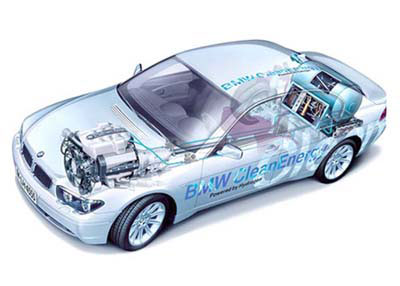| Nov 02, 2012 |
From rocket fuel to clean cars
|
|
(Nanowerk News) Austrian manufacturer MagnaSteyr has adapted technology developed for the Ariane rocket to build clean-burning cars that can use hydrogen instead of petrol for fuel.
|
|
Hydrogen is the smallest molecule in the Universe. That makes keeping it in one place very, very difficult. To tap its tremendous potential as a fuel, spacecraft must be able to store liquid hydrogen at extremely low temperatures, then feed it smoothly to rocket engines.
|
|
When ESA was developing its hydrogen-fuelled Ariane rockets, it turned to Austria’s MagnaSteyr to build tightly sealed fuel lines and double-walled storage tanks capable of trapping and holding liquid hydrogen and oxygen.
|
|
“It’s a technical challenge to handle that correctly,” says Gerald Poellmann, the head of Magnasteyr’s Hydrogen Center of Competence.
|
|
“The tolerance areas are very small, the sealing needs to be tight, the materials can’t have any cracks, you need to prevent evaporation through the materials.”
|
|
“The expertise developed working with ESA on hydrogen storage gave MagnaSteyr a wealth of experience,” says Andrea Kurz from Brimatec, ESA’s Technology Transfer Programme partner in Austria.
|
|
“It made it possible for the company to enter a new business area. To apply the same technology to a very different high-performance engine, designed for the autobahn rather than outer space.”
|
|
MagnaSteyr worked with German carmaker BMW to develop hydrogen storage tanks small enough to fit in the boot of a BMW 7 Series saloon.
|
|
The pilot project succeeded in creating a production car in 2007 that burned hydrogen as fuel, dubbed the BMW Hydrogen 7.
|
 |
| The BMW Hydrogen 7 car with its liquid hydrogen-powered combustion engine and a fuel tank developed based on space technology from the European Ariane rocket.
|
|
Space tech fuel tank for ultra-clean motoring
|
|
Years of working on Ariane rockets gave MagnaSteyr critical knowhow, Dr Poellmann says: “We used the experience of designing components for hydrogen to apply the technology in this BMW tank.”
|
|
It was a significant technical achievement. For decades, manufacturers have been trying to figure out how to use hydrogen to power cars.
|
|
Plentiful and clean-burning, the element has tremendous promise as a green energy source.
|
|
“Hydrogen is the cleanest fuel available,” he says. “It’s a very future-oriented way of generating energy without any pollution.”
|
|
Essentially the only emission from a liquid hydrogen-powered combustion engine is water vapour.
|
|
The challenge for carmakers is working out how to make use of it. To store as a liquid, hydrogen must be kept at –253°C, which usually requires constant refrigeration.
|
|
BMW Hydrogen 7 cars store 114 litres of liquid hydrogen in highly-insulated fuel tanks instead. The equivalent of 17 m of Styrofoam, the tanks’ insulation can keep the hydrogen cold for almost two weeks.
|
|
BMW eventually built 100 of the hydrogen-fuelled cars, which also use regular petrol. The luxury sedans are still used to shuttle VIPs at special events.
|
|
“We learned a lot with those cars,” says BMW spokesman Ralph Huber. “Several million kilometres were driven with them.”
|
|
Even if the project proved the worth of liquid hydrogen as an almost pollution-free car fuel, it also highlighted some limitations for which technical solutions need to be found before liquid hydrogen driven cars are to be seen everyday on our roads.
|
|
One is that as the liquid hydrogen warmed, it boiled into a gas, and was slowly vented off. That meant a driver leaving the car at the airport for two weeks would return to an empty fuel tank.
|
|
And liquid hydrogen can’t be found at just any filling station: there are fewer than ten pumps in the world equipped to fuel the cars.
|
|
Car companies are also looking at fuel cells, which generate electricity from hydrogen and are easier to work with than liquid hydrogen, though not as powerful.
|
|
Even so, liquid hydrogen needs storage and the MagnaSteyr ‘space-technology’ tanks is a first step along the way.
|
|
Whatever form it takes, BMW’s Ralph Huber is sure that “In the long term, hydrogen will be one of our solutions for sustainable mobility.”
|
|
ESA’s Technology Transfer Programme Office (TTPO)
|
|
The main mission of ESA's Technology Transfer Programme is to facilitate the use of space technology and systems for non-space applications, and thereby also further demonstrating realising the benefit of the European space programmes to the citizens.
|
|
ESA TTPO is responsible for defining the overall approach and strategy for the transfer of space technologies and systems, including the incubation of start-up companies at ESA business incubation centres and related funding.
|
|
The office has transferred over 260 technologies since the programme start and is supporting directly and indirectly around 100 new start-ups a year. TTPO has also initiated as a limited partner the Open Sky Technology Fund, a €100 million venture fund which invests in start-ups using space technology.
|

